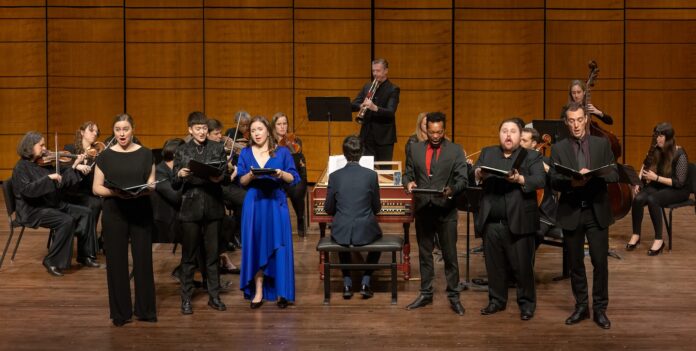Unlike some other Opera Lafayette presentations (last season’s spectacular “Io,” for example), Thursday’s take on the Moreau eschewed extras such as the ‘sumptuous “’Persian-style’ taffeta costumes” teased in the program. It was a choice that effectively kept our focus trained on the music, but also divorced the experience a bit from the blush-inducing sensation of its 1689 premiere at St. Cyr, Maintenon’s academy for young women.
French musicologist Anne Piéjus created the evening’s edition of the Moreau, its ten excerpts selected by harpsichordist Justin Taylor (who led the Opera Lafayette orchestra with energy and heart) and his co-musical director, the bass-baritone Jonathan Woody (who serves as the company’s artistic associate).
The ensemble said not a word but went straight to its work — an approach I prefer most nights, but was surprised at on Thursday, given the amount of context and background information swirling around the program. Ample program notes and a pair of well-researched historical essays were provided digitally, but attendees who didn’t brush up on the night’s themes beforehand were largely left to their own devices.
This wasn’t really an issue once the “Overture” started, briskly played and smartly steered by Taylor, who was able to guide the strings — seven violins, two viola, cello and bass — through expressive, elastic tempos. The sturdy undergirding lines of cellist Serafim Smigelskiy were immediately arresting, beautifully supporting Taylor’s glimmering harpsichord. And concertmaster Jacob Ashworth was simply superb.
Soprano Paulina Francisco delivered a strong performance that, like much of the singing on Thursday, felt a touch too tightly reined in. Her opening aria (“Pleurons et gémissons”) showcased her clarity and control, and when supported by soprano Elisse Albian and alto Kristen Dubenion-Smith (whom I struggled to hear), the shine of her voice was easier to discern — her agility on particular display in “Un roi sage” and the aching “Il s’appaise, il pardonne.”
But, apart from a glorious trio in the final minutes, the singers never quite attained the confidence of sound that the players enjoyed throughout. A translucent “Prelude” of gossamer strings segued into an elegant, energetic “Entracte.” A vivacious “Marche” roused the room into sitting up straight like a gust of fresh air. And throughout, the ensemble brought a sound that was bright, brisk and alive. Special credit goes to oboist Margaret Owens and bassoonist Anna Marsh for pulling double-duty with sprightly, skillful recorder playing.
Premiered in 1718, Handel’s “Esther” is both prototypical and unusual. Piéjus notes that the work “inaugurates the form of Handel’s oratorios to come” with its succession of individual arias and ensemble passages. But it also amounts to a dramatic head-scratcher, largely due to Handel recycling music from a previous work (the “Brockes Passion” of 1712) for nine of its 21 segments.
The oratorio brought three more singers to the stage: tenors Patrick Kilbride and Jesse Darden (the latter singing the role of Ahasuerus), and bass-bartione Woody, whose Haman peeled the oratorio open with a sinister “Pluck root and branch.”
Soprano Margot Rood was forced to withdraw from the show due to a covid diagnosis (a detail unmentioned by anyone from the stage), shifting the role of Esther to an apparently well-prepared Francisco, who gave a splendid performance in a pinch. If anything, the soprano sounded more at home in the Handel, at ease with its ornamentation and more attuned to its drama.
Taylor was especially exciting to watch through this second half, locking into charming pizzicato figures with the cello and violas under bright, unfurling violins. On oboe, Owens was a special standout, her clean, cool, nimble lines in gorgeous conversation with Francisco’s voice. Some of my favorite music of the night came in “Who dares intrude … Who calls my parting soul from death,” where a sumptuous duet between Francisco and Darden hovered over Handel’s centuries-removed stab at minimalism.
Woody’s two turns toward the oratorio’s close — “Turn not, O Queen” and “How art thou fall’n from thy height” — showed formidable power and, especially in this role, an impactful mix of gravel and gravitas. Woody strained to meet a high note or two, but maintained an electric presence onstage — one that his colleagues never quite matched.
Joined by triumphant bursts of strings and winds, John Thiessen’s bracing trumpet (celebrating the slaying of the enemies) brought the oratorio to an exuberant finish, the six singers aglow in a glorious polyphonic weave. Glancing around the orchestra, Taylor stoked some extra heat into its final measures before coming in for a gentle landing — and the kind of ovation that forgives a bumpy flight.



